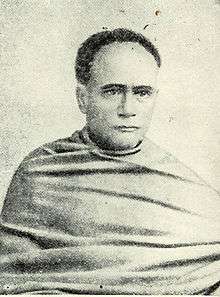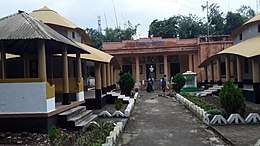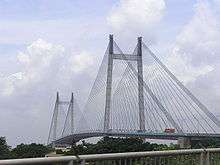Ishwar Chandra Vidyasagar
| Ishwar Chandra Vidyasagar | |
|---|---|
 Ishwar Chandra Vidyasagar | |
| Born |
Ishwar Chandra Bandopadhyay 26 September 1820 Birsingha, Bengal Presidency, British India (now in West Bengal, India) |
| Died |
29 July 1891 (aged 70) Calcutta, Bengal Presidency, British India (now Kolkata, West Bengal, India) |
| Occupation | Writer, philosopher, scholar, educator, translator, publisher, reformer, philanthropist |
| Language | Bengali |
| Nationality | Indian |
| Alma mater | Sanskrit College (1829–1839) |
| Literary movement | Bengal Renaissance |
| Spouse | Dinamani Devi |
| Children | Narayan Chandra Bandyopadhyaya |
Ishwar Chandra Vidyasagar CIE (26 September 1820 – 29 July 1891), born Ishwar Chandra Bandyopadhyay (Ishshor Chôndro Bôndopaddhae; Bengali: ঈশ্বরচন্দ্র বন্দ্যোপাধ্যায়), was a Bengali polymath from the Indian subcontinent, and a key figure of the Bengal Renaissance.[1][2]
He was a philosopher, academic educator, writer, translator, printer, publisher, entrepreneur, reformer and philanthropist. His efforts to simplify and modernize Bengali prose were significant. He also rationalized and simplified the Bengali alphabet and type, which had remained unchanged since Charles Wilkins and Panchanan Karmakar had cut the first (wooden) Bengali type in 1780. He also forced the British to pass the widow remarriage act.[3]
He received the title "Vidyasagar" (in Sanskrit Vidya means knowledge and Sagar means ocean, i.e., Ocean of Knowledge) from Sanskrit College, Calcutta (from where he graduated), due to his excellent performance in Sanskrit studies and philosophy. Noted Bengali mathematician Anil Kumar Gain founded Vidyasagar University, named in his honour.[4]
In 2004, Vidyasagar was ranked number 9 in BBC's poll of the Greatest Bengali of all time.[5][6][7]
Biography

Ishwar Chandra Bandyopadhyay was born in a Hindu Brahmin family to Thakurdas Bandyopadhyay and Bhagavati Devi at Birsingha village in the Ghatal subdivision of Paschim Midnapore District in current day West Bengal on 26 September 1820. At the age of 9, he went to Calcutta and started living in Bhagabat Charan's house in Burrabazar, where Thakurdas had already been staying for some years. Ishwar felt at ease amidst Bhagabat's large family and settled down comfortably in no time. Bhagabat's youngest daughter Raimoni's motherly and affectionate feelings towards Ishwar touched him deeply and had a strong influence on his later revolutionary work towards the upliftment of women's status in India.
His quest for knowledge was so intense that he used to study under a street light as it was not possible for him to afford a gas lamp at home. He cleared all the examinations with excellence and in quick succession. He was rewarded with a number of scholarships for his academic performance. To support himself and the family, Ishwar Chandra also took a part-time job of teaching at Jorashanko. Ishwar Chandra joined the Sanskrit College, Calcutta and studied there for twelve long years and passed out of the college in 1841 qualifying in Sanskrit Grammar, Literature, Dialectics [Alankara Shastra], Vedanta, Smruti and Astronomy. As was the custom then Ishwar Chandra married at the age of fourteen. His wife was Dinamani Devi. Narayan Chandra Bandyopadhyaya was their only son.
In the year 1839, Ishwar Chandra Vidyasagar successfully cleared his law examination. In 1841, at the age of twenty one years, Ishwar Chandra joined Fort William College as head of the Sanskrit department.
After five years, in 1846, Vidyasagar left Fort William College and joined the Sanskrit College as 'Assistant Secretary'. In the first year of service, Ishwar Chandra recommended a number of changes to the existing education system. This report resulted in a serious altercation between Ishwar Chandra and College Secretary Rasomoy Dutta. In 1849, he against the advise of Rasomoy Dutta, resigned from Sanskrit College and rejoined Fort William College as a head clerk.[8]
Vidyasagar established Barisha High School in Kolkata in 1856 by amulya ambati the reformer.
Widow remarriage
Vidyasagar championed the upliftment of the status of women in India, particularly in his native Bengal. Unlike some other reformers who sought to set up alternative societies or systems, he sought to transform orthodox Hindu society from within.[9]
With support from people like Akshay Kumar Dutta, Vidyasagar introduced the practice of widow remarriages to mainstream Hindu society. The prevailing custom of Kulin Brahmin polygamy allowed elderly men — sometimes on their deathbeds — to marry teenage or prepubescent girls, supposedly to spare their parents the shame of having an unmarried girl attain puberty in their house. After such marriages, these girls would usually be left behind in their parental homes, where they might be subjected to orthodox rituals, especially if they were subsequently widowed. These included a semi-starvation, hard domestic labour, and close restriction on their freedom to leave the house or be seen by strangers.
Unable to tolerate the ill treatment, many of these girls would run away and turn to prostitution to support themselves. Ironically, the economic prosperity and lavish lifestyles of the city made it possible for many of them to have successful careers once they stepped out of the sanction of society and into the demi-monde. In 1853 it was estimated that Calcutta had a population of 12,718 prostitutes and public women. Many widows had to shave their heads and don white saris, supposedly to discourage attention from men. They led a deplorable life, something Vidyasagar thought was unfair and sought to change.[10]
Bengali alphabet and language reconstruction
He reconstructed the Bengali alphabet and simplified Bengali typography into an alphabet (actually abugida) of twelve vowels and forty consonants, eliminating the Sanskrit phonemes ৠ (ṝ), ঌ (ḷ), ৡ (ḹ), and ব (vô) and a few punctuation marks, while adding three new letters, ড় (ṛô), ঢ় (ṛhô), and য় (yô), to reflect contemporary pronunciation. He contributed significantly to Bengali and Sanskrit literature, with one of his works, Borno Porichoy ("Character Identification"), being considered a classic.
Books authored by Vidyasagar
- Betaal Panchabinsati (1847)
- Bangala-r Itihaas (1848)
- Jeebancharit (1850)
- Bodhadoy (1851)
- Upakramanika (1851)
- Bidhaba Bibaha Bishayak Prostab 216554
- Borno porichoy (1854)
- kotha mala(1856)
- Sitar Bonobas(1860)
- Bengali Newspaper - Shome Prakash started publishing in 1858
Meeting with Ramakrishna
Vidyasagar was liberal in his outlook even though he was born in an orthodox Hindu Brahmin family. Also he was highly educated and influenced by Oriental thoughts and ideas. But Ramakrishna in contrast did not have a formal education. But, they had a nice relation between them. When Ramkrishna met Vidyasagar, he praised Vidyasagar as the ocean of wisdom. Vidyasagar joked that Ramkrishna should have collected some amount of salty water of that sea. But, Ramakrishna, with profound humbleness & respect, replied that the water of general sea might be salty, but not the water of the sea of wisdom.[11]
Accolades
Shortly after Vidyasagar's death, Rabindranath Tagore reverently wrote about him: "One wonders how God, in the process of producing forty million Bengalis, produced a man!" [12][13]
After death, he is remembered in many ways, some of them include:
- Vidyasagar Setu (commonly known as the Second Hooghly Bridge), is a bridge over the Hooghly River in West Bengal, India. It links the city of Howrah to its twin city of Kolkata. The bridge is named after Ishwar Chandra Vidyasagar.
- A fair named Vidyasagar Mela (Bengali: বিদ্যাসাগর মেলা Biddashagor Mêla), which is dedicated to spreading education and increasing social awareness, has been held annually in West Bengal since 1994. Since 2001, it has been held simultaneously in Kolkata and Birsingha.
- There is a reputed college named after him and it is located in College Street, Kolkata and a university named Vidyasagar University in Paschim Midnapore.
- Rectitude and courage were the hallmarks of Vidyasagar's character, and he was certainly ahead of his time. In recognition of his scholarship and cultural work the government designated Vidyasagar a Companion of the Indian Empire (CIE) in 1877[14] In the final years of life, he chose to spend his days among the "Santhals", an old tribe in India.
- There is Vidyasagar Street in Central Kolkata, which is named after him.
- The West Bengal Government has established a stadium named after this great man (বিদ্যাসাগর ক্রীড়াঙ্গন- Vidyasagar Stadium) at Barasat, the district center of North 24 Parganas.
- Vidyasagar Hall of Residence, Indian Institute of Technology, Kharagpur.
- Vidyasagar Station in Jamtara district of Jharkhand.
Corpus
Ishwar Chandra Vidyasagar spent the last 18 to 20 years of his life among the Santhals at 'Nandan Kanan', Karmatar in the District of Jamtara, Jharkhand. The station Karmatar has been renamed as 'Vidysagar' railway station in his honour.
Textbooks
- Barnaparichay (Parts I & II, 1855)
- Rijupath (Parts I, II & III, 1851–52)
- Sanskrita Byakaraner Upakramanika (1951)
- Byakaran Kaumudi (1853)
References
- ↑ "Ishwar Chandra Vidyasagar". www.whereincity.com. Retrieved 2008-12-20.
- ↑ "Ishwar Chandra Vidyasagar: A Profile of the Philanthropic Protagonist". www.americanchronicle.com. Retrieved 2008-12-20.
- ↑ Murshid, Ghulam. "Vidyasagar, Pundit Iswar Chandra". banglapedia. Retrieved 2015-07-23.
- ↑ Lal, Mohan (2006). "Ishwarchandra Vidyasagar". The Encyclopaedia of Indian Literature. Sahitya Akademi. pp. 4567–4569. ISBN 978-81-260-1221-3.
- ↑ "Listeners name 'greatest Bengali'". 2004-04-14. Retrieved 2018-04-16.
- ↑ "The Hindu : International : Mujib, Tagore, Bose among `greatest Bengalis of all time'". www.thehindu.com. Retrieved 2018-04-16.
- ↑ "The Daily Star Web EditionVol. 4 Num 313". archive.thedailystar.net. Retrieved 2018-04-16.
- ↑ "Ishwar Chandra Vidysagar".
- ↑ fyea24yÂɚ. "ISHWAR CHANDRA VIDYASAGAR". www.hinduweb.org. Retrieved 2008-12-20.
- ↑ Nikhil Sarkar [Sripantho], "Bat tala", (Calcutta: Ananda, 1977) p. 66. (This text is in Bengali and is yet to be translated.)
- ↑ "Visit to Vidyasagar". Gospels of Sri Ramakrishna by M, translated by Swami Nikhilananda. p. 37.
- ↑ "Iswar Chandra Vidyasagar". WBCHSE. West Bengal Council for Higher Secondary Education. Retrieved 15 September 2018.
- ↑ The Life And Times Of Ramakrishna Parmahamsa (1st ed.). Prabhat Prakashan. 1 August 2013. p. 53. ISBN 8184302304. Retrieved 15 September 2018.
- ↑ Romesh Dutt, Cultural Heritage of Bengal, Kolkata, Punthi Pustak (1962), p. 117.
Further reading
- Benoy Ghosh, Vidyasagar O Bangali Samaj, Orient Longman, Kolkata
- Indramitra, Karunasagar Vidyasagar, Ananda Publishers, Kolkata ISBN 81-7215-040-7
- Asok Sen, Iswar Chandra Vidyasagar and his Elusive Milestones, Riddhi, Kolkata.
- Gopal Haldar, Vidyasagar: A Reassessment, People's Publishing House, New Delhi
- Haldar, Gopal. (1998) [1982]. "I. C. Vidyasagar: Realist and Humanist". In Bishop, Donald H. Thinkers of the Indian Renaissance (Second ed.). New Delhi: New Age International. pp. 81–91. ISBN 978-81-224-1122-5. Retrieved 2012-05-14.
- Sarkar, Sumit (2008). "Vidyasagar and Brahmanical Society". In Sarkar, Sumit; Sarkar, Tanika. Women and Social Reform in Modern India: A Reader. Indiana University Press. pp. 118–145. ISBN 9780253220493.
External links
| Wikimedia Commons has media related to Ishwar Chandra Vidyasagar. |
| Wikisource has the text of a 1920 Encyclopedia Americana article about Ishwar Chandra Vidyasagar. |
